To celebrate the Winter Olympics, and to continue our ongoing discussion about what is and isn’t a sport, please enjoy this legal opinion from the Sport Court, Emily Smith, Jake Wolf, and Andrew Buonopane.
Opinion of the Court
By a vote of 2-1, Figure Skating is not a sport.
U.S. FIGURE SKATING v. INTERNAL REVENUE SERVICE
CERTIORARI TO THE UNITED STATES COURT OF APPEALS FOR THE SECOND CIRCUIT
[February 4, 2014]
CHIEF JUSTICE HOLT delivered the opinion of the Court.
I
Following this Court’s decision in National Hockey League v. United States (2013), U.S. Figure Skating brought suit against the United States. The association is the recognized governing body for its athletic organization in the United States per the U.S. Olympic Committee (USOC).
Appellant brought suit after it was exempted from the Taxation Post-Sport Exportation Act (2013) following the movement of U.S. Figure Skating from Colorado Springs, CO to Minneapolis, MN. The Internal Revenue Service (IRS), the agency responsible for collecting the tax monies and distributing them to the previous municipality, exempted the association, as it did not consider figure skating to be a “sport” based on the criteria set out in National Hockey League. U.S. Figure Skating, per the brief submitted to the Court, believed it to be their “patriotic duty” to pay lawfully enacted taxes and filed suit, alleging that the athletic arts it represents do in fact qualify as a “sport” according to National Hockey League.

I’ve got your criteria right here.
In the case arising from Sport Taxation Post-Exportation Act (2013), we were asked to determine what is and is not a sport. In deciding this case the Court has used standards which can be applied in future cases to assess whether a given activity meets the qualifications to be called a sport.
The four facets that must be present for an activity to be recognized as a sport are:
1. Rules and Regulations
This includes both the fundamental laws by which a game operates as well as the mechanics that create an established structure such as organized competitions, referees, coaches, and governing bodies. This criterion has been established to protect recreational activities that are not subject to the jurisdiction of this law.
2. Specialized Athleticism
This component is what separates sport from non-athletic competitions which fall under the category of games (chess, cards, knowledge based games.) In order to be considered athletic, a sport must directly involve several aspects of physical exertion: strength, endurance, speed, or agility. In addition, the participants in the sport must posses these skills in a specialized manner which makes them distinct from the general population. An example of this would be the difference of skills possessed by a father and son playing catch versus a major league baseball pitcher.
3. Competitive in Nature
A sport must be competitive in nature to distinguish it from demonstrative feats of athleticism – i.e. a 100-yard dash as opposed to parkour where an individual is only attempting to express creativity. In order to be competitive a sport must either have teams or individuals vying against one another for a victory only achievable by one entity. In the parameters of this law, this will only extend to those teams and/or individuals involved in large-scale organized competitions with Rules and Regulations as outlined in the first section.
4. A Quantifiable and Definite Outcome
An outcome that is quantifiable and objective is what separates “athletic events” and games from sport. There are many activities which feature all three of the preceding criteria but are not classified as a sport because their outcomes are based on the subjective standards of judges. It is the opinion of this Court that sports are only those competitive, athletic events which have an outcome that is based on the performance of the team/individual against a competitor or competitors and not on the subjective evaluation of said performance.

The most important criterion of all: Goalie fights.
II
It is surreal enough to have to defend this institution’s tax-exempt status against itself, but to do so while trying to convince its members to appreciate their real dignity is truly baffling. The focus of the deliberations regards the fourth criterion stated in National Hockey League: that a sport must have a quantifiable and objective goal. In simple sports, such as running, the goal is quite plain: to run faster than all opponents. Which competitor runs faster is objective and easily quantified in time. The faster the competitors run, the more likely each of them is to win. In complex team sports, such as the game of baseball, a variety of athletic operations contribute to a team’s unified output, which is measured in runs, points, goals, etc. The more a team scores relative to its opponent, the more likely it is to win. No such statement is possible in the cases of the appellant’s events because there is no corresponding objective determinant for victory and defeat. In figure skating there is no factor, such as fastest time or runs scored, which directly controls the outcome.
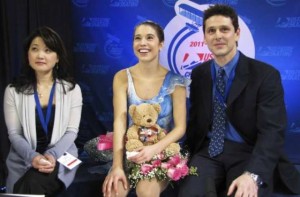
Pardon?
It may be contested, with mounting furor no doubt, that the highest scores in figure skating is what determine victory, just as in team sports. Just as a team’s various operations all feed into its score, so the various components of a figure skater’s routine all feed into his or her score. But what exactly are those components and how are they measured?
We are agreed with the dissenting minority that the Technical Component is not disputed, because it measures the difficulty of routines, which is more or less quantifiable. The Program Component’s five subheadings, however, must all meet the objectivity criterion. These five subheadings are: Skating Skills, Transition/Linking Footwork and Movement, Performance/Execution, Choreography/Composition, and Interpretation.
III
Skating Skills is judged based on the competitor’s “effortless power,” which, strictly speaking, is a contradiction in terms. What is meant is “seemingly effortless power,” which is just as much an aesthetic effect as a means to skating well. Contrast this with the manifest effort expended by a speed skater in the final lap of a record run, or a pitcher in baseball nearing the end of a complete-game shutout, or the guttural cries of exhaustion of a tennis champion in the fifth set of a match. The fact that they seem to be expending great effort does not detract from their imminent triumphs.
Transitions/Linking footwork which is defined by U.S. Figure Skating as “The varied and/or intricate footwork, positions, movements and holds that link all elements. In singles, pairs and synchronized skating, this also includes the entrances and exits of technical elements.” On the surface this seems not to veer too far from the criteria of sport, but the necessity of variety raises an interesting question. Certainly in sport we see that variety is an important aspect. A football team that only had one play would be fairly easy to defeat no matter how impressive the play. But variety is not always so important. In baseball, at least in the misguided American League, the position of the Designated Hitter is the antithesis of variety. A Designated Hitter plays no fielding position (except in the most extreme cases), but has one and only one role, to hit. This is even more evident in most track and field events, which consist exclusively of one action, such as the high jump. They need no variety in their play, in fact that would be detrimental to their value. This is admittedly a small complaint, but the importance placed on a variety of movements evidences the focus on beauty which will be discussed more at length below.
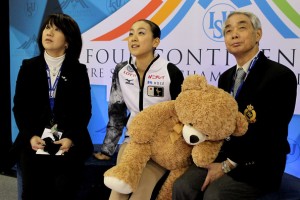
The final three components are what truly separates figure skating from sport: Performance/Execution, Choreography/Composition, and Interpretation. All of these components focus in some way on artistic merits rather than on athletic prowess. Performance/Execution is the physical, emotional, and intellectual involvement of the competitors as they translate the intent of the music and choreography (performance); the quality of movement and precision in delivery (execution). Choreography/Composition is an intentional, developed and/or original arrangement of all types of movements according to the principles of proportion, unity, space, pattern, structure, and phrasing. Interpretation is the personal and creative translation of the music to movement on ice.

Of the three, Performance/Execution is the least troublesome when considering the fourth criterion. In all team sports it is imperative that teams function as one unit—a statement proven true by the amount of speculation done about locker room discord when a team is struggling. In sport, however, this is not a way that teams are ever evaluated empirically. There are no bonus points awarded at the end of a hockey game to the team that was more emotionally and intellectually involved with one another during the game. Choreography/Composition is also something that is found in all sports. As with the previous component though the difference between sport and the athletic arts is that in sport there is no subjective evaluation of these elements which impacts the final score. A recent example could be seen in the 2014 NFL Playoff game between the Kansas City Chiefs and the Indianapolis Colts; the Colts fumbled the ball, it bounced of a player’s back, and quarterback Andrew Luck picked it up and ran it in for a touchdown. It was an ugly and unscripted play with little or no artistic merit.
Finally we come to the most controversial of the components: Interpretation. It is here that figure skating takes its most divergent leap from sport. Here we are not speaking of the judges’ interpretation of the performance (which is its own issue discussed below) but evaluating the performers based on how well they interpret the music. This is a purely subjective criterion which looks at an equally unquantifiable idea and the moment at which, even if all other scoring components passed the test, figure skating would be deemed primarily art and not sport.

Sorry
IV
While the dissent will without a doubt throw out the outlandish outfits sometimes worn by golfers and the individualistic elements sometimes added by players to uniforms and equate them to the costumes worn in figure skating, it seems the linguistic discrepancy here is enough to render this point moot. Not even our overly enthusiastic counterparts in the dissent would use the term costume to describe what is worn in baseball, football, and the like. These athletes wear uniforms. A uniform’s primary purpose is to designate members of a team as one entity—they serve a primarily functional purpose. A costume’s primary purpose is to promote individuality—their purpose is to add to the visual and artistic element of the performance. Here again we see that the primary focus is on art and not sport. Furthermore, the argument that the music which accompanies figure skating routines is in any way similar to the inclusion of music at sporting events is absurd.
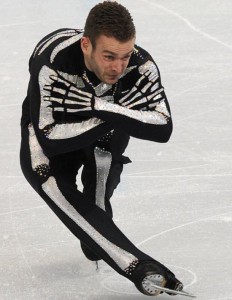
Intimidating the Karate Kid is not a sport.
It might be objected that the judges who award scores in figure skating are no different than rules officials in undisputed sports, such as referees and umpires. Rules officials determine conformity to the rules of the game just as judges determine the merits of a skating performance. Each has its subjective elements, so is there a true difference? Rules officials do not decide how well or poorly the competitors have attained their objective, they only ensure that the rules of conduct are observed. A referee would be equally satisfied with a clean losing effort as with a clean winning effort, and more satisfied in either than with a winning effort in which the victor committed penalties. In real life, the police only monitor road safety; they do not reward drivers for reaching their destinations on time. In sports, rules officials only monitor legality; they do not have the power to reward competitors for success. In figure skating, judges are the sole source of points awarded in a competition. In order to make the analogy between judges and referees work then, it would be as if referees evaluated the technical and program components of a football team’s drive down the field and then awarded them 7 points, 3 points, or no points based on their evaluation of the drive’s artistic merits. This is obviously not the case and framing it as such makes the allegation that referees and judges are the same in kind seem rather silly.
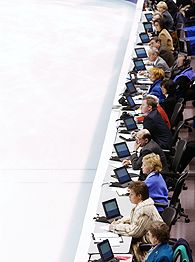
The scorekeeping in sports is essential to the object of the game. The scorekeeping in these other events is not essential. Take the scorekeeping away from baseball, and you are left with an exercise whose incompleteness is a punishment for those who are not responsible enough to compete in a healthy manner. Take the scorekeeping away from figure skating, and you have Disney on Ice. To score figure skating can even take away from the experience in some respects.
Another point often mentioned by supporters of figure skating’s sporthood is its degree of difficulty. None on this Court would suggest that these events are not incredibly challenging and beyond the scope of what any of us judges could hope to attain. It should go without saying that ruling that these are not sports does nothing to lessen their inherent difficulty. Plenty of things are demanding, but are not sport – navigating government bureaucracy, for example. Figure skating requires as much, if not more, athleticism required by some sports, so clearly this takes nothing away from the dedication and training needed to compete in these events at the highest level.
While we’re near the subject, it behooves us to examine the relationship between art and sport. Though some may argue that we in the majority are a stodgy old bunch who see no possible connection between the finer things in life and our beloved real sports, it is in fact the case that they often intersect – from the swing of a baseball bat to graceful puck-handling in hockey, there are many beautiful and artistic aspects to even the most violent of sports. Sport then is not without art – which is defined in its most narrow terms in the Oxford Dictionary as, “the expression or application of human creative skill and imagination, typically in a visual form such as painting or sculpture, producing works to be appreciated primarily for their beauty or emotional power.” One simply has to marvel at the marriage of power and elegance of a pitcher’s wind-up and release to see that art can be found in sport. It is this artistic element of sport that leads us to wax poetic about the game and to relish its visual beauty. This relationship though is how sport differs from “the athletic arts.” Unlike in sport, figure skating’s primary focus is on beauty. While figure skating has undeniable and rigorous athletic requirements, these are not the main focus of the performance. The focus is on beauty, perfection, and showmanship. There is no room for deviation from the aesthetic norms of the event. The sport is based not on athleticism but how the athleticism is perceived and presented. It is not simply that figure skaters skate quickly for that would be speed skating. It is that figure skaters do this in a way that is aesthetically beautiful and delighted in for its own sake. Within sport, however, the aesthetic dimension is enjoyed as a secondary benefit of the event. Athletes can deviate greatly from an aesthetic ideal and still find success. An unorthodox quarterback like Bernie Kosar or a knuckleballer like R.A. Dickey would utterly fail to meet the ideals undergirding the standards of figure skating. It is this fundamental difference in focus that is what keeps figure skating from being classified as sport.
V
Therefore figure skating does not fall under the category of sport, but rather the category of athletic arts. This should not be in any way taken as an insult. It seems as though many in the world of athleticism have succumbed to an ESPN-dominated worldview, in which sport is the utter summit of live entertainment. There is an emerging attitude that if it isn’t a sport, it is somehow deficient, and this attitude is enough to drive US Figure Skating to demand to be taxed, as bizarre as that is. This attitude is unduly detrimental not only to this organization’s finances, but to its very identity as an athletic art. There is a certain dignity to the athletic arts that is not shared by sports. Though qualities of each are present in the other in a secondary form, the unique benefit of sports to humanity is the struggle for victory, whereas the unique benefit of athletic arts is the enjoyment of the activity itself. There is a certain utilitarian quality which is proper to sports, but which is not necessary for the athletic arts. Figure skating, along with ballet, synchronized swimming, and parkour to name a few others, can be delighted in simply because they are beautiful to behold, and not because they are means to the all-consuming end of wining. Therefore, US Figure Skating should be proud not to be considered a sport, not only because of the tax benefits, but because of the beauty which it possesses as athletic art. The opinion of the U.S. Tenth Circuit Court of Appeals is affirmed.
It is so ordered.
JUSTICE WOLF, dissenting.
The Court in this case has held that Figure Skating is not a sport, based on the rules established for determining sport in National Hockey League v. United States. The minority, however, believes that these arbitrary rules are far too narrow and exclude many deserving so-called “athletic arts” that are excluded even from consideration by these standards. It is unfortunate that the majority can hardly mask its condescension in stripping figure skating of its rightful status as a sport.
With the first three points in the standard established in National Hockey League, no fault is found and as written the appellants in this case meet all of the standards. To wit, figure skating operates within rules and regulations. These events also require of their participants a level of specialized athleticism unseen in many other sports. Figure skating requires a level of precision unmatched even by the most fine-tuned southpaw. And finally, this event is competitive in nature, pitting both individuals and teams against each other – often competing over multiple unique events. It is therefore clear that this event meets and exceeds the first three criteria of the standard.
Here though is where the main issue with the standard lies. To declare that any athletic event in which scoring is done by a judge is not a sport is blatantly wrong. Looking at the bigger picture, there exists in all of the big four sports an arbitrary judge – referees and umpires. Whilst these actors do not award points in the same manner as judges in figure skating, they are able to directly overturn scoring plays in many instances, directly affecting the outcome of a game and are therefore in a sense responsible for awarding points much as a judge in the athletic event examined in this case.
Those in the majority will argue that this power to overturn/confirm scoring plays, goals, and other plays is not the same as judges evaluating performances and awarding points. This assertion however could not be farther from the truth. In figure skating judges use a strict set of rules in order to award or subtract points. It is not an arbitrary system by any means. In baseball, umpires use a strict set of rules in order to judge a strike from a ball—their judgment is as arbitrary as some argue those of the judges in gymnastics and figure skating are. In fact, in the sport that Justice Buonopane seems to elevate above even the gods, each umpire uses a variable, largely subjective strike zone that invariably determines the outcome of the game. Each sport has a subjective nature; humanity is unable to truly provide objectivity, thus an allowable amount of subjectivity has been built into each sport. However, it should be recognized that sports such as figure skating have more readily implemented video instant replay than more traditional sports, such as baseball and football. Whereas there is limited instant replay in football–confined to under the two minute warning and to two challenges per team–and in baseball is used only to determine the validity of dubious homeruns, figure skating enacted instant replay long ago to determine the precise placement of blades on ice. This allows the officials to determine whether an athlete properly performed a land, jump, etc. by landing on the correct side of the blade, for example; this ability to rewatch and rejudge certainly decreases the subjectivity of the officials.
Since the majority seems blissfully unaware–or worse, willfully ignorant–of the standards governing the sports–and I use that term with the full intention of riling my ill-informed colleagues on the bench–presented before us, I shall take it upon myself to inform them. In Figure Skating, competitors are judged twofold; they are given a Technical Score and a Program Component Score. I doubt my counterparts would quibble with the former, as it awards certain elements a set score and is then graded for quality; the two are then combined to give a score. Justice Smith indicated during oral arguments that she agreed that the Technical Score qualified as a largely impartial determiner deserving of a sport.
It is hard to see how the Program Component, favoring technique and ability, is different from other skating disciplines that the majority would undoubtedly deem worthy of receiving their knighthood as a sport. Note the focus on technical competence, difficulty, and ability are highlighted. Some may argue that difficulty should be irrelevant; after all, the difficulty of a pass in football does not determine the game and is, in fact, plays no role in determining the outcome. However, this is ignoring a basic fact: precision often does affect the outcome of a sport. It is the more precise hits along the lines in tennis that win a match; this merely codifies already practiced principles. Criteria used to judge the Performance/Execution element include body carriage, projection, clarity of movement, unison and spatial awareness (in pairs), and style. Once again, these are factors that influence the outcome of every sporting event; the “sweet swing” of Ken Griffey, Jr. certainly contributed to his batting prowess and offensive dominance and the manner of pitching unique to those like Orlando Hernandez–where the knee is brought up to block the vision of hand location prior to pitch release–contributed to his success. Once again, Figure Skating merely codified these abilities to create a more objective way to judge such pure, finessed talent.
Choreography/Composition and Interpretation are what the majority finds so egregious and morally repugnant in its ruling today. While it is true that music has long played an important part in a variety of traditional sports–from entrance songs and “Take Me Out to the Ballgame” in baseball–to “pump up” music during hockey games, the majority is correct to note that these do not have direct influence over the outcome of the sporting event. Nevertheless, it demonstrates that there is not the complete separation of the Arts from sports, for which the majority so desperately pines.
My colleagues on the bench seem to desperately fear the intersection of art and sport, treating it as if musical interpretation and Johnny Weir’s costumes will single-handedly defeat the Western World. Perhaps instead we should celebrate an addition to a sport and celebrate that uniformity and conformity are not always a necessity. Briefly, on costumes: the costumes used in figure skating are no more essential than the stirrups associated with baseball, the stockings associated with football, the garish outfits of Payne Stewart, or the throwback uniforms across a variety of Big Four sports teams. None of these play an essential function, but add to the sport stylistically. The Court claims that figure skating is more art than sport, but, using the scoring outlined by U.S. Figure Skating and supported by this Court, the endeavor actually consists of 70-80% “sport”, depending on whether the third element of the Program Score Component is accepted.
Figure skating displays the criteria set forth in National Hockey League: the rules and regulations are exhaustively outlined, it is undisputed that the participants are athletes, and there are winners and losers in the sport. Finally, the governing body of the disputed “athletic art”–if I should be so politically correct–have established the above specific criteria to determine “quantifiable and definite” winners and losers. The Court erred gravely in its judgment today.
Perhaps we should follow the recommendations and regulations put forth by the Olympic Charter and consider this “athletic art” a sport. The International Olympic Committee and United States Olympic Committee are the premier authorities on sports and are legally recognized as such by Congress; it would be most appropriate if the majority should put aside its judicial activism for a moment and reflect the will of the Legislature. I dissent.

The authors, Emily Smith, Jake Wolf, and Andrew Buonopane, live in the general Washington, DC/Ithaca, NY metropolitan area and maintain a the Sport Court Blog with similar in-depth discussions of sportishness. Stay tuned in the coming days and weeks for the more divisive and complicated Biathlon case and a summary of our judicial endeavors.
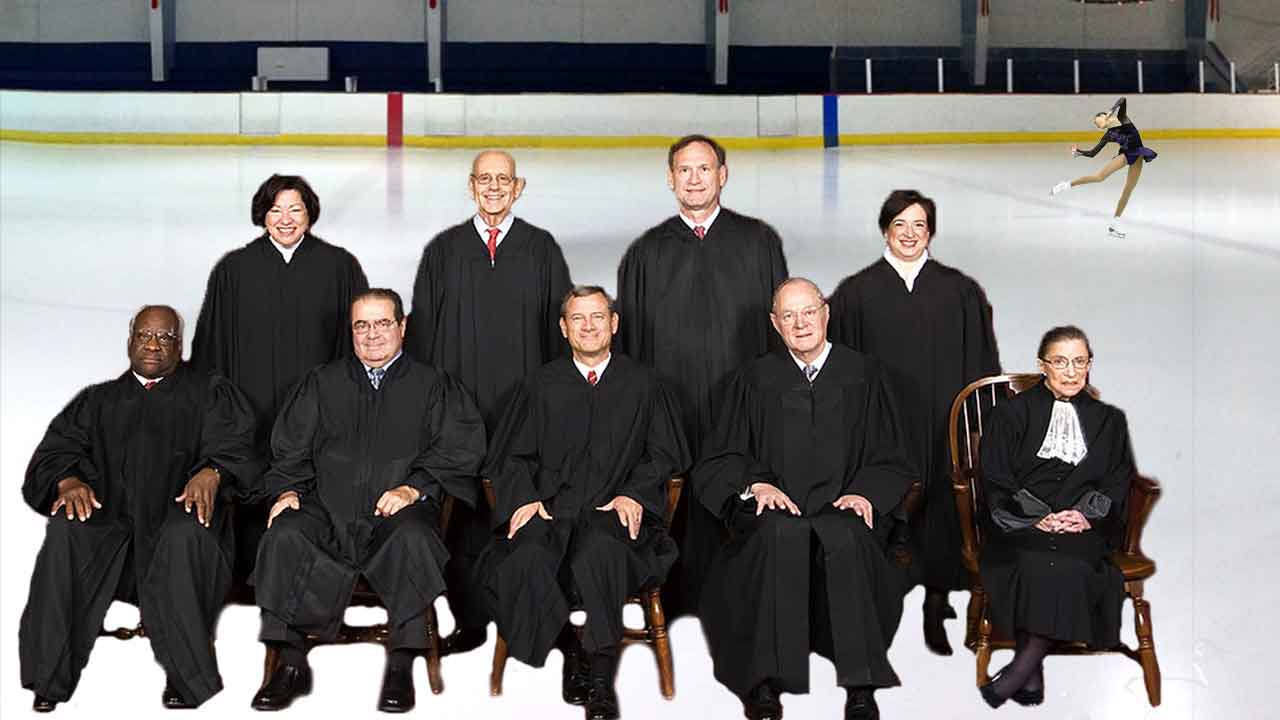
While I like the idea of “athletic art” as a category (which would include my beloved pro wrestling), I have to wonder if subjective judging is really such a determining factor in deciding sportishness. In addition to the subjective decisions of referees in major team sports, there is also the role of subjective decisions in boxing, mixed martial arts, and other combat sports. Few would dispute that these are legitimate sports, the occasional match-fixing scandal aside*. However, while some bouts end in a more or less objectively determined manner (the 10-count, or a submission in MMA), most fights end with either the referee deciding that one fighter can no longer continue or with the judges deciding to award the win to one fighter at the end of the time limit. The criteria for these decisions are much vaguer than those in figure skating, and fans frequently disagree with decisions by both referees and judges. Does this mean that boxing, one of the oldest sports in the world, is in fact not a sport? Interesting food for thought.
*Arguably boxing also wouldn’t pass the first criteria of being centrally organized.
I would argue that in sports like figure skating points are awarded based on the difficulty of elements, which may range from things obviously skill based (ie being able to land a triple lutz is harder than landing a double lutz) or more subtle, skating in time to music is no joke, while in many sports you have a chance to psych yourself up and prepare for a difficult element in figure skating you are on a fast moving train, and categories like choreography or interpretation are used to reward skaters who skate with a higher level of difficulty and are more skillful. Honestly this decision is a classic example of people who know nothing about figure skating, except what they may see on the local news. If they actually skated, or talked to someone who skated I’m sure they’d change their mind
Emily, if you had read the article, then you would have seen in section IV that the authors agree that figure skating is an impressively difficult activity. Also you seem to suggest that points in figure skating are awarded solely on the basis of difficulty. If this were true, then it seems to follow that the winning performance would be the one that consists of the highest number of the most difficult moves. Is this true? Did the figure skater that won gold win because she pulled off eight triple axels, whereas the silver winner only completed six? This seems clearly false as a description of how judges assess performances.
I did not see the requirement of “A definite and quantifiable outcome” in the act that they are interpreting. As this appears to be the the critical factor in the analysis, I wonder where it comes from, and how important it is to the “sport-ness” of an activity.
Is it perhaps related to gender roles, distinguishing the masculine-coded activity of accomplishing definite tasks to earn a certain number of points from a feminine-coded unquantifiable activity?
“In addition, the participants in the sport must posses these skills in a specialized manner which makes them distinct from the general population. An example of this would be the difference of skills possessed by a father and son playing catch versus a major league baseball pitcher.”
So, when I, an unexceptional (indeed, athletically underwhelming) member of the general population, go and play tennis (with all the rules and scoring included), I’m not playing a sport? What level of ability at tennis need I attain before my tennis match transitions from ‘game’ to ‘sport’? If my opponent happens to be Roger Federer, does his ability lift the level of the entire match into the realm of sport, or is he playing sport while I, on the other side of the net, am only playing a game?
The father and son playing catch may only be playing a game. But when they get with other players and organise into teams to play baseball, they’re playing a sport. No matter how atrociously terrible they are at it.
I know this comes from the case you quoted. But it is pretty ridiculous.
I have always held that a “sport” must have the ability to be settled by an objective outcome that relies on only the participants in the activity and not by the subjective opinion of a third party. Therefore, boxing qualifies as the subjective opinions of the judges is only used as a last resort; while figure skating does not qualify as it can ONLY be subjectively judged by third parties.
I have never separated “games” and “sports”. If you have two people playing darts or beer pong or chess they are playing a sport.
I dig the cover picture. Sets the tone nicely.